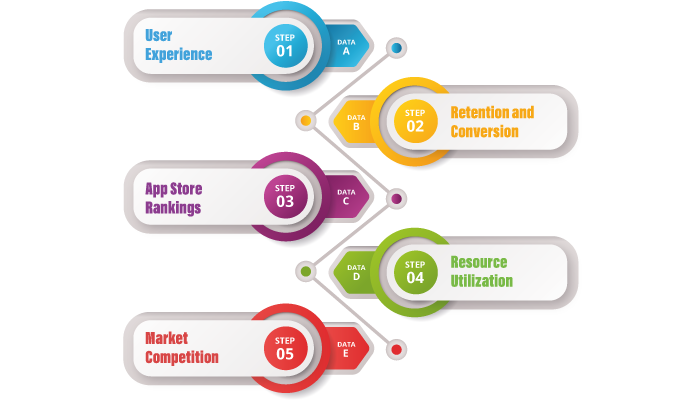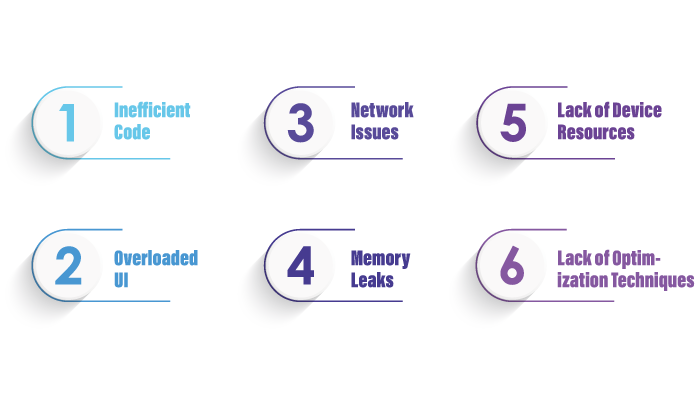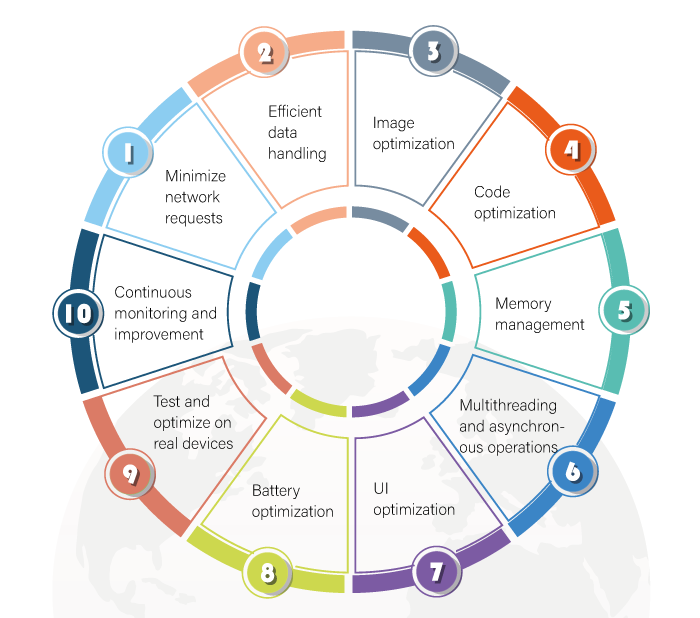Table of Contents
Mobile apps are new front of business, causing mobile app development to skyrocket.
But it has also created a problem.
You see, one smartphones were first introduced till today, a lot has changed. While businesses didn’t realize the potential of mobile apps, today, every business is running to create a mobile app of their own.
Well, with this, the mobile app market, both App Store & Play Store filled with millions of apps. And 100s of new ones are coming every week.
Due to this crowding of mobile app marketplace, creating a mobile app isn’t enough. What you need is mobile app performance optimization.
This is a crucial part of creating a successful app. And in this blog, we shall be learning all about it. Let’s get right into it, starting with the basic.
What is Mobile App Performance Optimization?

Mobile app performance optimization! Doesn’t ring any bells? Well, if you are new to this concept, let us introduce you to the same.
The term “Mobile app performance optimization” refers to the process of improving the performance and efficiency of a mobile application to enhance its speed, responsiveness, and overall user experience.
Performance optimization involves identifying and resolving issues that may cause slow loading times, laggy animations, high battery consumption, excessive memory usage, and other performance-related problems.
Moreover, the goal of mobile app performance optimization is to ensure that the app performs well on various mobile devices, operating systems, and network conditions.
And optimizing app performance is crucial because users have high expectations for speed and responsiveness. Plus, they are more likely to abandon or uninstall an app if it performs poorly.
Why Is Mobile App Performance Optimization Important?

Mobile app performance is important!
Without satisfactory performance, mobile app won’t rank of app store or capture record breaking downloads.
And that’s why you need to optimize app performance.
There are a range of other reason why this is important. So, let’s discuss each of these points below:
User Experience
User experience is important!
A smooth and responsive app enhances the user experience. Users expect apps to load quickly, respond promptly to their actions, and provide a seamless navigation experience.
If an app is slow, unresponsive, or prone to crashes, users are likely to abandon it and switch to a competitor’s app.
If you are still in the development stage, you can utilize UX Design frameworks to create a better user experience for your app and the end customers.
Coming back to the topic, optimizing app performance ensures a positive user experience, leading to increased user satisfaction, engagement, and retention.
Retention and Conversion
App performance directly affects user retention and conversion rates. A poorly performing app can frustrate users, resulting in uninstalls and negative reviews.
On the other hand, a fast and efficient app encourages users to stay longer, explore more features, and complete desired actions such as making a purchase or subscribing to a service.
With mobile app performance optimization, you can increase user retention and improve conversion rates.
App Store Rankings
It goes without saying that everyone want their mobile app to rank on App Store, one of the biggest success factor.
But when it comes to app stores, they take into account various factors when determining app rankings. User ratings, reviews, and engagement metrics are some of the key factors considered.
A poorly performing app is more likely to receive negative reviews and low ratings, which can impact its visibility and discoverability in the app stores.
By optimizing performance and delivering a superior user experience, you increase the chances of positive reviews, higher ratings, and improved visibility in the app stores.
Resource Utilization
Mobile devices have limited resources such as CPU, memory, and battery life.
If an app is not optimized, it can consume excessive resources, leading to slower performance, increased battery drain, and overall device sluggishness. And this is a big reason why are apps rejected by App Store.
Therefore, optimizing app performance ensures efficient resource utilization, allowing the app to run smoothly without significantly impacting the device’s performance or battery life.
Market Competition
Lastly, the mobile app market is highly competitive, with millions of apps vying for users’ attention.
Users have a wide range of choices, and they are more likely to opt for apps that offer superior performance.
By optimizing your app’s performance, you gain a competitive advantage, differentiate your app from competitors, and increase the likelihood of attracting and retaining users.
These are some of the top reason why mobile app performance optimization is important. And with this out of the way, let’s look at problems in mobile app performance.
What Causes Mobile App Performance Problems?

For mobile app performance optimization to be successful you need to recognize issues in the performance.
Now, you can do this with mobile app test. But there are some common issues that are often found in mobile app performance.
To save you time and effort, we shall be discussing these issues. Therefore, these are, as mentioned below:
· Inefficient Code
Poorly optimized or inefficient code can lead to slow app performance.
This includes excessive CPU or memory usage, inefficient algorithms, frequent object creation and destruction, or unoptimized database queries.
· Network Issues
Slow or unreliable network connections can significantly impact app performance.
Network latency, high packet loss, or slow server response times can result in delayed data retrieval, slow loading times, and unresponsive app behavior.
· Lack of Device Resources
Mobile devices have limited resources such as CPU, memory, and battery life.
Moreover, apps that consume excessive resources can lead to performance degradation, including slow response times, app crashes, or excessive battery drain.
· Overloaded UI
A cluttered or overloaded user interface with excessive animations, complex layouts, or too many visual elements can negatively impact app performance.
This can cause slow rendering, UI freezes, or unresponsive interactions.
· Memory Leaks
Memory leaks occur when an app fails to release allocated memory, resulting in gradual memory consumption and degraded performance.
Continuous memory leaks can lead to crashes and reduced device responsiveness. And this can be a big issue in mobile app performance.
· Lack of Optimization Techniques
Failing to implement mobile app performance optimization techniques, such as caching, asynchronous programming, or code minification, can hinder app performance.
Ignoring these practices can lead to slower loading times, increased network usage, and reduced overall efficiency.
Now that you know the problem, let’s see how you can measure your mobile app’s performance in the section below.
How Can You Measure Your Mobile App Performance?

How do you know whether you need to redesign the app or just make some minor code fixes? Well, this is where app performance measuring comes in.
If you want to lead a successful mobile app optimization drive to improve it’s performance, you need to understand the issues. And for that, you need to measure mobile app performance.
This is where some key performance indicators come in to help you with the same. Here, we shall be going through these.
They are, as mentioned below:
· App Downloads
The number of times your app has been downloaded from the app store(s) indicates its initial popularity.
· Active Users
This KPI tracks the number of users actively using your app within a specific time frame, such as daily or monthly active users (DAU/MAU).
· Retention Rate
This metric measures how many users continue to use your app over time. It’s typically calculated as a percentage and indicates user engagement and satisfaction.
· Session Length
This KPI measures the average duration of each user session within your app. Longer sessions generally indicate higher user engagement.
· Conversion Rate
If your app has specific goals like making purchases or subscribing to a service, tracking the conversion rate helps measure how successful your app is at driving users towards those desired actions.
· User Acquisition Cost (UAC)
UAC measures the cost required to acquire each new user for your app. It’s essential for evaluating the effectiveness of your marketing and advertising strategies.
· App Crashes and Errors
Monitoring the frequency of app crashes, errors, and other technical issues helps identify and fix bugs that may affect user experience.
· App Load Time
The time it takes for your app to load and become usable is crucial for retaining users. Slow load times can lead to user frustration and abandonment.
· Average Revenue Per User (ARPU)
ARPU calculates the average revenue generated by each user of your app. It helps measure the monetization potential and effectiveness of your app’s business model.
· Customer Satisfaction
Collecting user feedback, ratings, and reviews provides insights into user satisfaction levels and helps identify areas for improvement. If satisfaction is low, you need urgent mobile app performance optimization.
· Churn Rate
Churn rate measures the rate at which users stop using your app. It’s important to track this metric to understand user attrition and take steps to retain users.
· In-App Engagement
Tracking user interactions within the app, such as the number of screens viewed, features used, or actions taken, helps gauge user engagement and the value provided by your app.
To measure these metrics, you can leverage various tools and techniques such as performance profiling tools (e.g., Android Profiler, Xcode Instruments), network monitoring tools, crash reporting services (e.g., Crashlytics, Firebase Crashlytics), analytics platforms (e.g., Google Analytics, Mixpanel), and user testing methodologies.
Or easier still, you can find mobile app developers and leave this work to them. In either case, it’s time to look into some of the top mobile app performance optimization techniques in the section below.
Mobile App Performance Optimization Techniques

Now that you know what is mobile app performance optimization, why it is important, how to find problems, and measure performance, it’s time to optimize it.
Well, in this section of the blog, we shall be going through some of the main mobile app performance optimization techniques.
These methods will help you solve some major issues and optimize the mobile app for a more smoother performance.
Therefore, with this being said, let’s get right into it:
1. Minimize network requests
Reducing network requests involves optimizing the communication between the mobile app and the server.
This can be achieved by consolidating multiple API calls into a single request, reducing unnecessary data transfers, and leveraging techniques like caching to store frequently accessed data locally.
In addition, compressing data before transmitting it over the network and using lazy loading to fetch data only when needed can help minimize the amount of data transferred.
2. Efficient data handling
Efficient data handling focuses on optimizing how the app processes and manipulates data.
This includes using efficient data structures, such as arrays or hash maps, to store and access data quickly.
It also involves minimizing unnecessary data manipulation, avoiding duplicate calculations, and optimizing algorithms to perform data operations more efficiently.
3. Image optimization
Image optimization aims to reduce the size of images without significant loss of quality.
This can be achieved through techniques like compression, where the image file is compressed to reduce its file size.
Additionally, resizing images to the appropriate dimensions for display on mobile devices helps reduce the amount of data that needs to be transferred and processed.
4. Code optimization
Code optimization involves identifying and improving areas of the app’s code that may be causing performance bottlenecks.
This can include optimizing algorithms and data structures to make them more efficient, removing unused or redundant code, and minimizing resource-intensive operations such as database queries or complex calculations.
Profiling tools can be used to identify specific areas of the code that require optimization.
5. Memory management
Memory management focuses on efficiently managing the app’s memory resources.
This includes properly managing object lifecycles to prevent memory leaks, releasing unused resources, and optimizing data storage to reduce memory consumption.
Techniques like object pooling, where reusable objects are stored and reused instead of creating new ones, can help minimize memory usage.
6. Multithreading and asynchronous operations
Multithreading and asynchronous programming techniques are used to perform time-consuming tasks in the background without blocking the main thread.
By offloading tasks like network requests or heavy computations to separate threads, the app’s responsiveness and smoothness can be maintained.
This prevents the UI from freezing or becoming unresponsive.
7. UI optimization
UI optimization focuses on improving the performance and responsiveness of the user interface.
This includes simplifying complex layouts, reducing the use of nested views, and using lightweight UI components where possible.
Avoiding unnecessary animations and leveraging hardware acceleration for graphics-intensive operations can also improve UI performance. It’s highly recommended that you use latest UI trends for better.
8. Battery optimization
Battery optimization techniques aim to reduce the app’s impact on the device’s battery life.
This involves optimizing background processes and minimizing their frequency, reducing the use of sensors and location services when not necessary, and optimizing network operations to minimize battery consumption.
Platform-specific features like Doze mode on Android or JobScheduler on iOS can be utilized to efficiently manage background tasks.
9. Test and optimize on real devices
Testing the app on real devices with different configurations and operating systems is essential to ensure optimal performance across a range of devices.
Profiling tools and performance monitoring can be used to identify specific performance issues and bottlenecks that may be device-specific.
This information can then be used to fine-tune the app’s performance on different devices.
10. Continuous monitoring and improvement
Ongoing performance monitoring and improvement involve collecting user feedback, monitoring app analytics and crash reports, and addressing performance-related issues promptly.
Regularly updating and optimizing the app based on user feedback and performance metrics ensures that the app continues to provide an optimal user experience over time.
Conclusion
Mobile app development is not enough. If you want to create a successful platform, you need to focus on mobile app performance optimization. And in this blog, we discussed all you need to know about the same.
Now, if you want to learn more about the same, it’s recommended that you consult a mobile app development company. And with this said, we conclude the blog.
FAQ
App performance optimization ensures a seamless user experience, boosts user engagement, and helps apps stay competitive in the market.
Thorough testing, efficient memory management, network optimization, image and media optimization, and implementing user analytics are key best practices.
Code optimization, asynchronous programming, caching, minification and bundling, and utilizing user analytics and monitoring are powerful techniques to optimize app performance.
Measure response time, loading time, frame rate, network performance, memory usage, battery consumption, crash rates, and leverage user analytics to measure your app’s performance.
Inefficient code, network issues, lack of device resources, overloaded UI, memory leaks, background processes, third-party libraries, lack of optimization techniques, and device fragmentation can cause performance problems.
Regularly measure app performance during development, testing, and post-launch. Continuous monitoring ensures timely identification of issues and ongoing optimization.
Conduct comprehensive testing on various devices, OS versions, and network conditions to ensure compatibility and optimize performance for different platforms.
Utilize performance profiling tools, network monitoring tools, crash reporting services, analytics platforms, and real-world testing to aid in optimizing app performance.
No, app performance optimization is an ongoing process. As technologies evolve and user expectations change, it’s crucial to continuously assess, optimize, and refine your app’s performance.
Optimal app performance leads to higher user satisfaction, increased engagement, better user retention, positive reviews, and ultimately, higher business revenue and growth.





No Comments
Comments are closed.